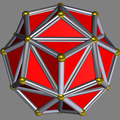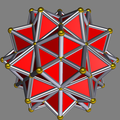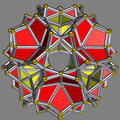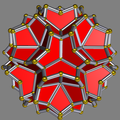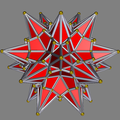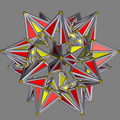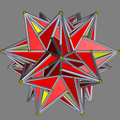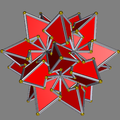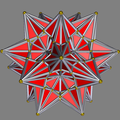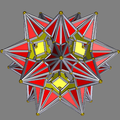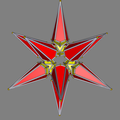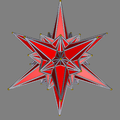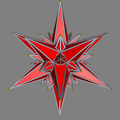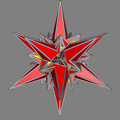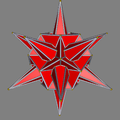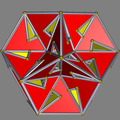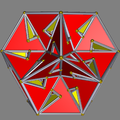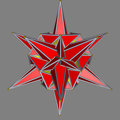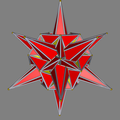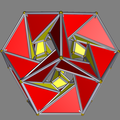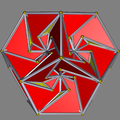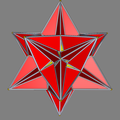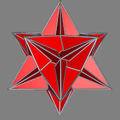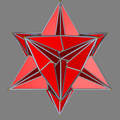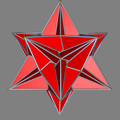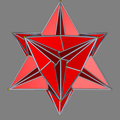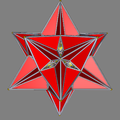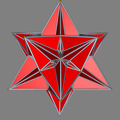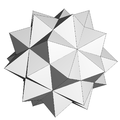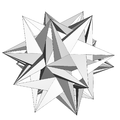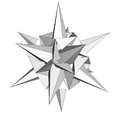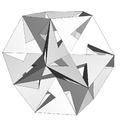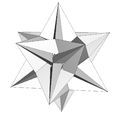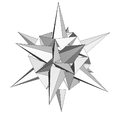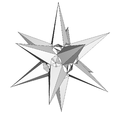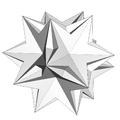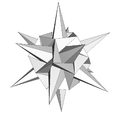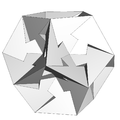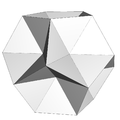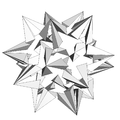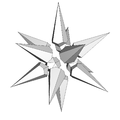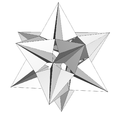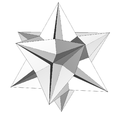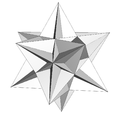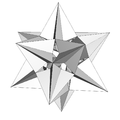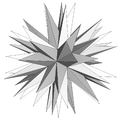Talk:The Fifty-Nine Icosahedra
| This article is rated C-class on Wikipedia's content assessment scale. It is of interest to the following WikiProjects: | ||||||||||||||||||||||||||||||||||
| ||||||||||||||||||||||||||||||||||
Crennells' index Nos.[edit]
Why the addition of a bar to every number? Also, the leading zeroes are not necessary for a column containing only numbers, and are not present in the book. -- Cheers, Steelpillow (Talk) 20:19, 30 July 2008 (UTC)
Hi Guy. It's a leading I, for "Icosahedron" so I could more clearly cross reference, like in table at Small_triambic_icosahedron. I would have made a subscript, but lazy first effort. I accept it may not be defendable, although no different than the W for Wenninger's book, only useful once you get outside of the book itself. Tom Ruen (talk)
- Well, I'm not sure why "I for icosahedron" should be reserved for the Crennell's list. Also, the table is beginning to look as if everybody carefully added their distinguishing prefixes, which is far from the case. IMHO it is better to delete the "I" and reference the stellations elsewhere in the manner of Bridge and others, by their DuVal cell notations.
- Sorry, forgot to sign. And that subscripting which has just appeared is not just misleading about the Crennell's notation, but it moves into the realms of original research. Sorry, it has to go. So whoa there cowboy! let's discuss any bright ideas before rolling 'em out 59 times plus cross-linking! off at the pass. -- Cheers, Steelpillow (Talk) 21:52, 30 July 2008 (UTC)
Okay, I's removed. Tom Ruen (talk) 22:26, 30 July 2008 (UTC)
DuVal symbols[edit]
And while I'm feeling grumpy, the new lot of DuVal symbols need a good working over with bold and italics. -- Cheers, Steelpillow (Talk) 21:57, 30 July 2008 (UTC)
- Yes, I figured a quick copy&paste to get all the symbols in was more important than completed pretty formatting. Tom Ruen (talk) 22:26, 30 July 2008 (UTC)
- On formatting I think e2f1f2 can be reduced to e2f1f2, putting everything under the same bold group. ... DARN, guess not, although a bit annoying! Tom Ruen (talk) 22:28, 30 July 2008 (UTC)
Maeder (1994) indexing[edit]
I see from Mathworld, there's a different ordering used:
- The stellations illustrated above are given in the ordering of Maeder (1994); Rogers uses a different ordering. Special cases are summarized in the following table. [1]
BUT it seems Maeder changed it afterwards as well. [[2]], yet another one! Tom Ruen (talk) 21:53, 31 July 2008 (UTC)
P.S. The Maeder indexing for the uniform polyhedrons ended up on Wikipedia because of Mathworld's prominence supporting it. U#Uniform_polyhedron#Indexing. [3] Tom Ruen (talk) 22:48, 31 July 2008 (UTC)
- I wouldn't bother. From what mathworld says about them, Maeder and Rogers based their work around modelling in Mathematica, and these lists have no wider significance. Can't speak for the uniform polyhedra, but I wouldn't be surprised if the same applies. Wikipedia should not include such listings unless and until they become adopted as standard by the wider community. Just chucking them onto Mathworld isn't a good enough reason. -- Cheers, Steelpillow (Talk) 07:14, 1 August 2008 (UTC)
Wenninger numbers[edit]
The subscript formatting needs to be removed here, as well. It is not used elsewhere, although the "W" prefix is and so that can stay. -- Cheers, Steelpillow (Talk) 07:14, 1 August 2008 (UTC)
- Maybe you're just being grumpy here? I don't know why you want to remove the subscripts. They're the same thing in my mind, just prettier. And they are used everywhere for the uniform polyhedra, like Small stellated dodecahedron. Mathworld uses subscripts equally [4]. Tom Ruen (talk) 01:48, 3 August 2008 (UTC)
- Well, I notice that the List of Wenninger polyhedron models does not use it, or does Johnson's list on Mathworld's Uniform Polyhedron. In fact neither of these tables uses the "W" prefix, and I am beginning think that our table should do the same - just as it does for the other indices. -- Cheers, Steelpillow (Talk) 19:27, 3 August 2008 (UTC)
Stellation diagram[edit]
There is a problem here in that Coxeter gave different numbering systems to the plane regions of the diagram and to the edge segments within the diagram (the region numbering was just a step on the way to the edge numbering). The numbers in the diagram are not related to Coxeter's numeric symbols for the various stellations. We are in danger of repeating the entire book if we don't draw a line somewhere. I think the stellation diagram should just show the regions unlabelled, and the article should not mention their numbering either. -- Cheers, Steelpillow (Talk) 19:36, 3 August 2008 (UTC)
- D'oh! We already have a stellation diagram at the top of the page. The one lower down can just go. -- Cheers, Steelpillow (Talk) 19:38, 3 August 2008 (UTC)
- This is not straight forward. The indices are based on Fig 4 in The fifty nine icosahedra (be careful not to use Fig 3), and an enlargement is given on P.71 of the 3rd edition. But not all are taken directly from the diagram: Index 5 represents faces 5 and 5, and so on for 6, 9 and 10. It would be possible to reproduce the enlarged version, taking care to get the bold and italics right, and then to add a note on the modifications. But none of this is central to the book's interest, and IMHO is going too far; best to just reference the book by implication (as at present). -- Cheers, Steelpillow (Talk) 10:10, 4 August 2008 (UTC)
explaining the columns in the list[edit]
The brief section on Du Val's contributions mentions his notation. Where can a reader find out more about his notation?
ISTM that the meaning of the columns in the list needs to be explained systematically. For example, one might suppose that the final stellation would be number 59, yet it is in row 8. Several columns have missing entries and it is not clear from the article why. What does "Not shown" mean? (described, but not illustrated?) What does "Taf." mean? Who is Bruckner (named twice, but not cited or linked)?
--Jtir (talk) 13:11, 6 August 2008 (UTC)
- Du Val's notation does need explanation, I agree. Some information can be found here. I do not know if there is a better web resource with nice pictures.
- I'll try to add something about the notations generally - basically they are all arbitrary and most lists are incomplete. "Not shown" is evidently there to indicate that Wenninger did not include it in his book; IMHO it looks awful and is the wrong way to show this, and blank entries would be best. What do people think? "Taf." is short for "Tafel", which is German for "Plate" (as in photographic). Bruckner wrote an earlier book which they appear in, and which The fifty nine icosahedra references. Yes, adding it here would do no harm.
- -- Cheers, Steelpillow (Talk) 19:43, 6 August 2008 (UTC)
- Thanks. It looks like a description of Du Val's notation would need a separate article with pictures.
- Yes. I think an article on Stellating the icosahedron would be cool. It should also cover other known stellations, such as Bridge's, and the issue of internal structure. -- Cheers, Steelpillow (Talk) 21:35, 7 August 2008 (UTC)
- Stellating the icosahedron — Excellent idea. --Jtir (talk) 23:18, 7 August 2008 (UTC)
- Yes. I think an article on Stellating the icosahedron would be cool. It should also cover other known stellations, such as Bridge's, and the issue of internal structure. -- Cheers, Steelpillow (Talk) 21:35, 7 August 2008 (UTC)
- Thanks. It looks like a description of Du Val's notation would need a separate article with pictures.
- "they are all arbitrary" — Interesting. Is an ordering not possible then?
- There is no unique mathematically significant ordering. However one could do better than the book, for example by working steadily outwards. AFAIK nobody has done so, and since Miller's rules are not definitive, there is little reason to bother. -- Cheers, Steelpillow (Talk) 21:35, 7 August 2008 (UTC)
- It puzzles me that Coxeter didn't do something like that. --Jtir (talk) 23:18, 7 August 2008 (UTC)
- Coxeter never revisited the subject - others who did, such as Bridge, got short shrift from him - this is oddly out of character, as he was usually very genial and helpful. One of life's little mysteries. -- Cheers, Steelpillow (Talk) 09:54, 8 August 2008 (UTC)
- It puzzles me that Coxeter didn't do something like that. --Jtir (talk) 23:18, 7 August 2008 (UTC)
- There is no unique mathematically significant ordering. However one could do better than the book, for example by working steadily outwards. AFAIK nobody has done so, and since Miller's rules are not definitive, there is little reason to bother. -- Cheers, Steelpillow (Talk) 21:35, 7 August 2008 (UTC)
- "they are all arbitrary" — Interesting. Is an ordering not possible then?
- "Not shown" — I agree that if there is no info in one of the sources, the cell should be blank. Incomplete info could be mentioned (e.g. described, but not illustrated).
- Wenninger illustrates them all. I doubt if even Coxeter read the whole of Bruckner for descriptions - it is very unreadable even in its native dialect of German. Happy for you to delete the "Not shown"s. -- Cheers, Steelpillow (Talk) 21:35, 7 August 2008 (UTC)
- I suspected that "Taf." was German. As this is the En. WP, and "Plate" or "Pl." is the obvious translation, that would seem to be better in the table. (Alternatively, a note could simply say what "Taf." means.)
- Coxeter wrote "Taf." because that was what Bruckner wrote. An explanation would be good. -- Cheers, Steelpillow (Talk)
- Done and added an exlink to images of the plates, even though they are are barely legible. --Jtir (talk) 23:18, 7 August 2008 (UTC)
- Coxeter wrote "Taf." because that was what Bruckner wrote. An explanation would be good. -- Cheers, Steelpillow (Talk)
- "Not shown" — I agree that if there is no info in one of the sources, the cell should be blank. Incomplete info could be mentioned (e.g. described, but not illustrated).
The new arrangement looks good. Thanks for adding the info on the cell notation. If that is Du Val's notation, shouldn't he get credit?
- No reason why not. Feel free. -- Cheers, Steelpillow (Talk) 22:16, 8 August 2008 (UTC)
For completeness, could something be said about Wheeler's column?
- I'll try. -- Cheers, Steelpillow (Talk) 22:16, 8 August 2008 (UTC)
Brückner's book shows far more than the 10 figures in his column. Even my untrained eye can tell that some of his models are not stellations of the icosahedron, but there are 98 total (my count) in Taf. VIII, IX, and X. Are there more that are not listed in his column?
- The list given is taken from The 59. It is possible that Coxeter missed one or more, but unlikely. -- Cheers, Steelpillow (Talk) 22:16, 8 August 2008 (UTC)
- Thanks for the clarification. Could you run your expert eye across them — there are some high res scans from VuV here. --Jtir (talk) 23:26, 8 August 2008 (UTC)
- I checked the book itself. Coxeter didn't miss any. -- Cheers, Steelpillow (Talk) 10:04, 9 August 2008 (UTC)
- Thanks for checking up on Coxeter. :-) BTW, there are captions in the lower right that say: "Lichtdruck von Römmler & Jonas, Dresden."? AFAICT, Lichtdruck is German for collotype, and Brückner had Römmler & Jonas take the photographs and print them. --Jtir (talk) 14:45, 9 August 2008 (UTC)
- I checked the book itself. Coxeter didn't miss any. -- Cheers, Steelpillow (Talk) 10:04, 9 August 2008 (UTC)
- Thanks for the clarification. Could you run your expert eye across them — there are some high res scans from VuV here. --Jtir (talk) 23:26, 8 August 2008 (UTC)
Couldn't "Crennell Index" be the column name?
- Just as "Wenninger Number", "Brückner Illustration" etc, could be column names. Why take up screen space? -- Cheers, Steelpillow (Talk) 22:16, 8 August 2008 (UTC)
- I apologize for being too oblique again. My thinking was that the name of the column and the name of the section describing the column ought to match, so readers don't have to guess at the mapping between the column description and the column it is describing. However, you suggest a better idea — why not explicitly describe the type of entry (units?) in each column. In IEEE 802.11#Protocols, units are given in some of the column headers and in FA Cup#FA Cup winners and finalists they are not, so I'm not sure what would be best here. --Jtir (talk) 23:26, 8 August 2008 (UTC)
- The main thing is to minimise clutter without loss of meaning. I'll think about the note. -- Cheers, Steelpillow (Talk) 10:04, 9 August 2008 (UTC)
- That looks good. Thanks for adding the note on Brückner's photos.
- Is it a list or a table? (I favor "table", BTW.)
- Could more be said about the significance or not of the reference numbers? ATM, the article says that the Crennells' numbers have some significance, and that Wenninger's have none. There is no explanation of Wheeler's numbers, and it is not at all clear that the "Face" numbers are referring to the numbers in the earlier stellation diagram.
- --Jtir (talk) 14:45, 9 August 2008 (UTC)
- The main thing is to minimise clutter without loss of meaning. I'll think about the note. -- Cheers, Steelpillow (Talk) 10:04, 9 August 2008 (UTC)
- I apologize for being too oblique again. My thinking was that the name of the column and the name of the section describing the column ought to match, so readers don't have to guess at the mapping between the column description and the column it is describing. However, you suggest a better idea — why not explicitly describe the type of entry (units?) in each column. In IEEE 802.11#Protocols, units are given in some of the column headers and in FA Cup#FA Cup winners and finalists they are not, so I'm not sure what would be best here. --Jtir (talk) 23:26, 8 August 2008 (UTC)
--Jtir (talk) 21:05, 8 August 2008 (UTC)
- It is a list which is presented in tabular form. I'll try to find something sensible to say about Wheeler's numbers, but by now the reader should be getting the idea. I think that the re-use of face numbers is self-evident enough, but if you have an urge for total unambiguity, feel free. -- Cheers, Steelpillow (Talk) 20:23, 9 August 2008 (UTC)
- The text in the section on the stellation diagram was too short for the space consumed by the image, so I merged that text into the description of the table and moved the diagram there (with a brief caption). --Jtir (talk) 18:36, 14 August 2008 (UTC)
- Nice one. -- Cheers, Steelpillow (Talk) 21:08, 14 August 2008 (UTC)
- The text in the section on the stellation diagram was too short for the space consumed by the image, so I merged that text into the description of the table and moved the diagram there (with a brief caption). --Jtir (talk) 18:36, 14 August 2008 (UTC)
- It is a list which is presented in tabular form. I'll try to find something sensible to say about Wheeler's numbers, but by now the reader should be getting the idea. I think that the re-use of face numbers is self-evident enough, but if you have an urge for total unambiguity, feel free. -- Cheers, Steelpillow (Talk) 20:23, 9 August 2008 (UTC)
sorting the table[edit]
[Copied from above. --Jtir (talk) 15:08, 8 August 2008 (UTC)]
Not showns removed. I wonder what character could be put in their to make the blanks sort last? Tom Ruen (talk) 04:27, 8 August 2008 (UTC)
- Good question. What tool are you using to sort? How do you import the table?
- One idea is to put a special character or string (e.g. "zzzzz") inside an HTML comment. It would not appear in the WP article, but with suitable pre and post processing the table could be sorted as desired.
- A google search found this discussion thread called "order by ASC with blanks last". The above approach is mentioned, as is this:
…in oracle you can say: order by XXXXX DESC NULLS LAST (or NULLS FIRST). shame you cant do this in MS ACCESS.
- So if the table were imported into a database, sorting with NULLS last might be possible.
- --Jtir (talk) 15:08, 8 August 2008 (UTC)
- "Excel’s Sort feature always moves blanks cells to the end of the sort."[5] --Jtir (talk) 15:15, 8 August 2008 (UTC)
- The sorting is done by javascript code included in the page by the
class=wikitable sortablemarkup. For more info, see Help:Sorting. To sort blanks to the end, try inserting:
- The sorting is done by javascript code included in the page by the
<span style="display:none">something_that_sorts_to_the_end</span>
- For example In the Wenninger column, insert:
<span style="display:none">9</span>
- -- Cheers, Steelpillow (Talk) 16:48, 8 August 2008 (UTC)
- Thanks! I was wondering about those icons in the column headers. Very nice.
- Help talk:Sorting#Sorting numbers mentions these templates: {{0}} for zero-padding and {{sort}} for specifying an arbitrary hidden sort key for displayed text. (They both use the "display:none" style.)
- The former can be used to hide the leading zero in Wenninger no. 4:
{{0}}4 Icosahedron
- It can also take an argument that is substituted for the zero. From Help:Sorting#Alphabetic sorting order, it looks likes '—' will sort last in alphabetical order, so this could be used for all blank cells:
{{0|—}}
- It all sounds good to me. -- Cheers, Steelpillow (Talk) 22:32, 8 August 2008 (UTC)
- I converted Wen. no. 4 to use the {{sort}} template, and it works, but the doc. says: "A table using this template should use it in all rows." Don't know why.
- There doesn't seem to be a simple template to do this:
- <span style="display:none">a_hidden_sort_key</span>
- --Jtir (talk) 22:40, 9 August 2008 (UTC)
- I sorted the columns with blanks last where that seemed seemed useful. If there are more let me know. Working on tables is even worse than working with <ref></ref> tags. There must be a better way. --Jtir (talk) 22:50, 12 August 2008 (UTC)
- It all sounds good to me. -- Cheers, Steelpillow (Talk) 22:32, 8 August 2008 (UTC)
images for Crennell 51[edit]
The images for Crennell 51 are identical to those for Cr 26. Cr 51 is also Wenninger 38, which is the thirteenth stellation, not the third. --Jtir (talk) 16:01, 10 August 2008 (UTC)
- Done. -- Cheers, Steelpillow (Talk) 20:08, 11 August 2008 (UTC)
Polyhedron of the week[edit]
Old images[edit]
See: Wikipedia:WikiProject Polyhedra
I added links to George Hart's VRML models, helpful at least until all images are added! Tom Ruen (talk) 05:39, 21 September 2009 (UTC)
- Made images for every one from Stella. Now the only problem is getting them in order.
-
0 (A)
-
1 (B)
-
2 (C)
-
3 (D)
-
4 (e2)
-
5 (De2)
-
6 (e1)
-
7 (De1)
-
8 (E)
-
9 (f1)
-
10 (f1)
-
11 (e2f1)
-
12 (Ef1)
-
13 (Ef1)
-
14 (De2f1)
-
15 (e1f1)
-
16 (De1f1)
-
17 (De1f1)
-
18 (e1f1)
-
19 (f2)
-
20 (e2f2)
-
21 (De2f2)
-
22 (De2f1f2)
-
23 (F)
-
24 (Ef1f2)
-
25 (Ef2)
-
26 (e2f1f2)
-
27 (g1)
-
28 (f1g1)
-
29 (f1g1)
-
30 (Ef1g1)
-
31 (Fg1)
-
32 (e1f1g1)
-
33 (De1f1g1)
-
34 (e2f1g1)
-
35 (Ef1g1)
-
36 (Ef1f2g1)
-
37 (De2f1g1)
-
38 (De2f1f2g1)
-
39 (e2f1f2g1)
-
40 (e1f1g1)
-
41 (De1f1g1)
-
42 (g2)
-
43 (f1g2)
-
44 (Fg2)
-
45 (G)
-
46 (f1f2g2)
-
47 (e2f1f2g2)
-
48 (Ef1f2g2)
-
49 (De2f1f2g2)
-
50 (e1f1f2g2)
-
51 (De1f1f2g2)
-
52 (e1f1g2)
-
53 (De1f1g2)
-
54 (f2g2)
-
55 (e2f2g2)
-
56 (De2f2g2)
-
57 (Ef2g2)
-
58 (H)
4 T C 09:37, 19 February 2010 (UTC)

- I've finally added the Du Val symbols for each icosahedron, eliminating the problem. Double sharp (talk) 12:16, 2 June 2012 (UTC)
- Using various more restricted subsets (built into Stella) one obtains the following sets of stellations:
- Primary: A, B, C, De1, De2f2, Ef1g1, Fg2
- Mainline: A, B, C, D, E, F, G, H
- Monoacral: A, B, C, D, De2, De1, Ef1, De2f2, Ef1g1, Fg2, H
- Fully supported: A, B, C, D, De2, De2f2, De1, E, Ef1, Ef1, Ef1g1, Ef2, Ef1f2, F, Fg2, Fg1, G, H
- Double sharp (talk) 12:26, 2 June 2012 (UTC)
New images[edit]
- Can we see them from a viewpoint not on a symmetry plane? —Tamfang (talk) 16:44, 2 June 2012 (UTC)
- I agree. It needs to be only slightly offset, and the same for all of them. Also, I find the rod-and-ball style to be unhelpful for clarifying the finer detail. Could something simpler, like the black lines in the current part-finished series, be used? Also, I personally would not colour them red but white, in honour of the 59 models made by HT Flather and still on display in the Mathematics library at Cambridge. It also offers maximum contrast in subtle shadowing, helping the 3D form to stand out.
- And I think there may be something else wrong - I can't see De2f2g2 in there, so there must be at least one incorrect label. — Cheers, Steelpillow (Talk) 20:31, 2 June 2012 (UTC)
- I like to use the incentre of the Schwarz triangle as the center of projection, to be "fair" to all the mirrors. An obvious alternative is the circumcentre, similarly "fair" to all the axes. —Tamfang (talk) 21:11, 2 June 2012 (UTC)

- Perhaps I have mixed up e1 and e2? The De1 image in the article looks like my De2 image!
- Is this labelled cell diagram correct? Or are e1 and e2 swapped?
- @Tamfang, Steelpillow: Here's a new version of H, with vertices and edges displayed in solid black and faces coloured white. I've changed the centre of projection. (Dotted lines are false edges.) What do you think?
- (I hope to upload them under the names File:Stellation_icosahedron_xxx.png, where x becomes Steelpillow's inline representation of the Du Val symbols (e.g. Ef1 becomes E,f1d). This should be less confusing than the current arbitrary numbering in Stella's sequence.) Double sharp (talk) 07:29, 3 June 2012 (UTC)
You do appear to have swapped e1 and e2. You also appear to have swapped f1 and f1 and consequently mirror-imaged your chiral models - at least, compared to the original book (I haven't checked the existing article, so I couldn't say where the error crept in)).
The cell diagram is not correct: f2 should connect to e2 but not to e1.
Personally I like the new style, though I can understand if others find it a bit boring. — Cheers, Steelpillow (Talk) 12:43, 3 June 2012 (UTC)
- I've fixed e1 and e2, which also fixes the cell diagram.
- About f1 and f1: yes, there is a problem! (Even worse, Stella generates some forms with f1 and some with f1, so there is no consistency in the mirroring.) Unfortunately I have already made a full set of images with the new style with the e1/e2 problem fixed but not the f1/f1 problem. At least it is not really a large issue (or is it?), as the stellation looks pretty much the same, even when mirrored. Double sharp (talk) 13:18, 3 June 2012 (UTC)
- It does make it easier to understand the finer details and compare similar forms if all the images stick to the same cell set. ISTR you should be able to override Stella in the cell diagram and manually turn off f1 and turn on f1. Sorry to be a pain. — Cheers, Steelpillow (Talk) 13:46, 3 June 2012 (UTC)
- Well, I can, but I'm worried about not having exactly the same orientation as the images that aren't affected, and I don't really want to replace the images that won't be affected (those which either don't have either f1 or f1, or have both). Double sharp (talk) 14:15, 3 June 2012 (UTC)
- Can you not simply create a model having the wrong handedness, then select and de-select cells in the cell diagram, without affecting the orientation? It's a few years since I used Stella, but I'm, pretty sure I remember doing that. If not, I guess that's that. — Cheers, Steelpillow (Talk) 16:14, 3 June 2012 (UTC)
- Yes. I'm now going through the whole set I uploaded yesterday, and checking which ones have f1 (and don't need to be replaced) and which ones have f1. The fixed set should be up soon. Meanwhile, the images are in the article. Double sharp (talk) 01:59, 4 June 2012 (UTC)
- Argh! I must have forgotten about this! (Then again at this size it's hard to see the details, so I think we're not too bad, though could be better.) Double sharp (talk) 03:12, 5 January 2015 (UTC)
- Yes. I'm now going through the whole set I uploaded yesterday, and checking which ones have f1 (and don't need to be replaced) and which ones have f1. The fixed set should be up soon. Meanwhile, the images are in the article. Double sharp (talk) 01:59, 4 June 2012 (UTC)
- Can you not simply create a model having the wrong handedness, then select and de-select cells in the cell diagram, without affecting the orientation? It's a few years since I used Stella, but I'm, pretty sure I remember doing that. If not, I guess that's that. — Cheers, Steelpillow (Talk) 16:14, 3 June 2012 (UTC)
- Well, I can, but I'm worried about not having exactly the same orientation as the images that aren't affected, and I don't really want to replace the images that won't be affected (those which either don't have either f1 or f1, or have both). Double sharp (talk) 14:15, 3 June 2012 (UTC)
- It does make it easier to understand the finer details and compare similar forms if all the images stick to the same cell set. ISTR you should be able to override Stella in the cell diagram and manually turn off f1 and turn on f1. Sorry to be a pain. — Cheers, Steelpillow (Talk) 13:46, 3 June 2012 (UTC)
Anyway, I've uploaded the complete set in the new style. The Du Val symbols are in the file names, with f1 = f1 and f1d = either f1 or f1). A fix for f1d/f1l is coming up.
Double sharp (talk) 02:16, 4 June 2012 (UTC)
File:Third compound stellation of icosahedron.png Nominated for Deletion[edit]

|
An image used in this article, File:Third compound stellation of icosahedron.png, has been nominated for deletion at Wikimedia Commons in the following category: Deletion requests September 2011
Don't panic; a discussion will now take place over on Commons about whether to remove the file. This gives you an opportunity to contest the deletion, although please review Commons guidelines before doing so.
This notification is provided by a Bot --CommonsNotificationBot (talk) 10:54, 3 September 2011 (UTC) |
File:Second compound stellation of icosahedron.png Nominated for Deletion[edit]

|
An image used in this article, File:Second compound stellation of icosahedron.png, has been nominated for deletion at Wikimedia Commons in the following category: Deletion requests September 2011
Don't panic; a discussion will now take place over on Commons about whether to remove the file. This gives you an opportunity to contest the deletion, although please review Commons guidelines before doing so.
This notification is provided by a Bot --CommonsNotificationBot (talk) 10:58, 3 September 2011 (UTC) |
File:First stellation of icosahedron.png Nominated for Deletion[edit]

|
An image used in this article, File:First stellation of icosahedron.png, has been nominated for deletion at Wikimedia Commons in the following category: Deletion requests September 2011
Don't panic; a discussion will now take place over on Commons about whether to remove the file. This gives you an opportunity to contest the deletion, although please review Commons guidelines before doing so.
This notification is provided by a Bot --CommonsNotificationBot (talk) 10:59, 3 September 2011 (UTC) |
Year of publication?[edit]
Shouldn't the year the book was published be included in the article? A reading reveals no such information. GalacticCircusDiplodocus (talk) 15:21, 26 December 2011 (UTC)
- Better now? — Cheers, Steelpillow (Talk) 16:49, 26 December 2011 (UTC)
Flather making models of all 59[edit]

I'm somewhat curious how he made a model of f2, which is disconnected. Double sharp (talk) 07:35, 23 March 2014 (UTC)
- He made a wire armature with 12 arms and poked a wire up the blunt end of each spike. FYI there are some photos in the Tarquin edition of the book, but I believe these to be of the wrong models. I once visited the faculty library where Flather's models are kept, and he made the full set in a uniform glossy white finish. Next to them was another display case full of mostly coloured polyedra, some made by Miller, others attributed to his students during a workshop, and some mystery beasts. The yellow f2 depicted in the book was among this coloured set, but it used a good many more wires and generally showed a poorer standard of workmanship, while Flather's white model was as I describe.
- FYI when Flather and Coxeter first met, Flather had already made a good many models which he was proposing to donate to the faculty. I recall reading somewhere that some of his icosahedra were not among the 59 (i.e. of "non-Miller" stellations), but cannot now place the reference. One or two of the coloured set look possible candidates. More certainly, Flather once wrote to Coxeter about a particular coloured model he had made and the Library catalogue even includes reference to the specific colours. Just one of those coloured polyhedra on display matches the colours described in the catalogue. Moreover, it not only has the gloss finish characteristic of Flather but is also a non-Miller stellation: in du Val's notation it would be Ce2. Could this model be the actual subject of Flather's letter to Coxeter? But when I visited the library had recently moved and not yet unpacked fully, they did not know the whereabouts of the letter itself. I have posted a photograph of it here, where it is the second one down the page.
- — Cheers, Steelpillow (Talk) 13:45, 23 March 2014 (UTC)
types of external cells[edit]

Is the caption misleading? If I understand right, there are ten kinds of exterior cell; this diagram enumerates the thirteen kinds of their facets. How about a diagram showing which two (or fewer) cell types have each facet? —Tamfang (talk) 05:36, 22 August 2019 (UTC)
Hang on, two kinds of facet are labelled "13"! —Tamfang (talk) 08:58, 22 August 2019 (UTC)
Also: How many kinds of infinite cell are there? —Tamfang (talk) 06:28, 22 August 2019 (UTC)
- You are correct. Fig.4 of The Fifty-Nine Icosahedra refers. The accompanying text identifies these as numbered regions of the plane (aka faces). The numbers do not necessarily identify a congruent set, they identify a set which must all occur together if Miller's rules are met. Fig.3 goes up to 14, before Coxeter simplified it down to Fig.4. I have corrected the caption.
- A diagram showing which two cells share each face would be difficult to make clear enough to be useful and would probably need to end up as a whole set of diagrams. The usual way to identify them visually is to look at the 3D images of the stellations which comprise a single cell set, it is hard to do better.
- The seven infinite faces are illustrated but not labelled in Figure 5 of my paper: Inchbald, G.; "Towards stellating the icosahedron and facetting the dodecahedron", Symmetry: Culture and Science, Vol. 11, 1-4 (2000) pp. 269-291.[6] The six infinite cell types are identified in Figure 3 of Tidy Dodecahedra and Icosahedra on my website, however that may only be referenced here if you folks decide I am a reliable source. Note that the faces which end in points at infinity in the published paper appear as the sides of prisms of finite cross-sectional area in the web illustration. I have never found a reason to number the face types and am not aware of anybody else who has published on the subject.
- — Cheers, Steelpillow (Talk) 12:11, 22 August 2019 (UTC)
I compared the stellation diagrams to the cells code, and got this:
| facet | inward cell | outward cell |
|---|---|---|
| 0 | a | b? |
| 1 | b | c? |
| 2 | c | d? |
| 3 | d | e1 |
| 4 | d | e2 |
| 5 | e1 | f1 |
| 6 | e2 | f1 |
| 7 | e2 | f2 |
| 8 | f2 | g2 |
| 9 | f1 | g2 |
| 10 | f1 | g1 |
| 11 | g2 | |
| 12 | g1 | |
| 13 | h |







